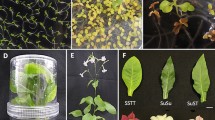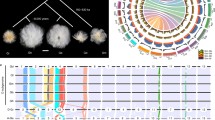Abstract
SKOVSTED1,2 brought forward considerable cytological evidence that New World (n = 26) cottons originated by amphidiploidy from crosses between ancestral Asiatic (n = 13) and American (n = 13) parents. Recently Harland3 and Beasley4 have independently synthesized by colchicine treatment amphidiploids from hybrids between present-day Asiatic and American diploid species. Since the synthesized amphidiploids produce partly fertile hybrids on crossing with present-day New World types, they contribute strong supporting evidence to Skovsted's theory. It should be pointed out, however, that such evidence can only be considered critical if it can be shown that genom combinations other than Asiatic + American do not pair equally well with the New World complement. I have brought forward5,6 phenogenetic evidence which suggests that critical examination of Skovsted's hypothesis may now be confined to testing combinations between Asiatic species and one or other of several entire-leaved species. The following combinations should be worth testing: It will be noted that all combinations except the fourth include an American diploid genom. Clearly if G. sturtii could be eliminated as a possible ancestor of New World cottons, Skovsted's hypothesis would be considerably strengthened. The low meiotic pairing found by Skovsted2 in New World × G. sturtii hybrids (A C D) and the high pairing found by Beasley7 in the corresponding hexaploid (A C D)2 certainly do not suggest G. sturtii as a possible parent—a conclusion which is supported by the data presented below.
This is a preview of subscription content, access via your institution
Access options
Subscribe to this journal
Receive 51 print issues and online access
$199.00 per year
only $3.90 per issue
Buy this article
- Purchase on Springer Link
- Instant access to full article PDF
Prices may be subject to local taxes which are calculated during checkout
Similar content being viewed by others
References
Skovsted, A., J. Genet., 28, 407 (1934).
Skovsted, A., J. Genet., 34, 97 (1937).
Harland, S. C., Trop. Agric., 17, 53 (1940).
Beasley, J. O., Amer. Nat., 74, 285 (1940).
Stephens, S. G., J. Genet. (in the press).
Stephens, S. G., NATURE [153, 53 (1944)].
Beasley, J. O., Genetics, 27, 25 (1942).
Stephens, S. G., J. Genet., 44, 272 (1942).
Skovsted, A., J. Genet., 30, 397 (1935).
Author information
Authors and Affiliations
Rights and permissions
About this article
Cite this article
STEPHENS, S. Meiosis of a Triple Species Hybrid in Gossypium. Nature 153, 82–83 (1944). https://doi.org/10.1038/153082a0
Issue Date:
DOI: https://doi.org/10.1038/153082a0
Comments
By submitting a comment you agree to abide by our Terms and Community Guidelines. If you find something abusive or that does not comply with our terms or guidelines please flag it as inappropriate.



